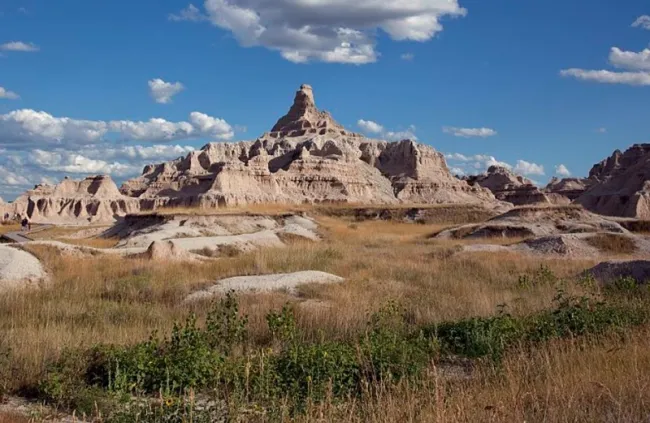
Badlands National Park, located in southwestern South Dakota, is a stunning landscape known for its sharply eroded buttes, pinnacles, and spires mixed with vast grasslands. The park spans over 244,000 acres and protects one of the world’s richest fossil beds, preserving ancient mammals like rhinos and saber-toothed cats. This unique geological formation offers dramatic views, wildlife viewing, and rich cultural history. The stark beauty of the Badlands draws visitors for its rugged scenery and outdoor recreation.
History of the Park
The Badlands have long been a significant area for the Lakota people, who named it "Mako Sica," meaning "bad lands," due to the challenging terrain and extreme conditions. In the 19th century, European settlers began exploring the region. It was designated as a national monument in 1939 and later became a national park in 1978. The park also holds historical significance as it contains remnants of Cold War-era Minuteman missile sites, which have been preserved for historical education.
Main Features
Badlands National Park is divided into two main units: the North Unit and the less-visited South Unit, co-managed by the Oglala Sioux Tribe. The park's main attractions include:
- Badlands Loop Road: This scenic drive offers breathtaking views of the eroded landscape, with several overlooks and trailheads.
- Fossil Exhibits: The park has a rich history of fossil discovery, and visitors can learn more about ancient life through exhibits and ranger programs.
- Wildlife Viewing: Bison, bighorn sheep, prairie dogs, and black-footed ferrets are just a few of the species you may encounter.
- Pinnacles Overlook: One of the most famous viewpoints in the park, offering expansive views of the badlands formations.
Types of Trails
Badlands National Park offers a variety of trails suitable for different skill levels:
- Easy Trails: Notch Trail, Door Trail, and Window Trail are short and accessible, offering spectacular views with minimal elevation gain.
- Moderate Trails: The Castle Trail is a 10-mile round trip that provides a more immersive experience of the park’s rugged terrain.
- Backcountry Hiking: For the adventurous, the park allows backcountry hiking where visitors can explore off the beaten path. There are no designated backcountry campsites, so hikers should be prepared for primitive conditions.
Crowd Expectations and Annual Visitors
Badlands National Park receives approximately 1 million visitors annually, with peak visitation occurring during the summer months. The park can be busy during the day, especially along the Badlands Loop Road and popular trails, but quieter areas can still be found. For those seeking a more solitary experience, early morning or late evening visits are recommended.
Accessibility for Seniors
Badlands National Park offers several features that cater to seniors. The Badlands Loop Road allows visitors to experience the park’s beauty from the comfort of their vehicle, with accessible overlooks for photography and rest stops. Some trails, like the Window and Door Trails, are relatively short and easy to walk.
Accessibility for Wheelchairs
The park provides some wheelchair-accessible options. The Fossil Exhibit Trail is a fully accessible boardwalk trail that allows visitors to explore a small portion of the park. Many of the overlooks along the Badlands Loop Road have accessible viewing platforms. However, due to the rugged terrain, the majority of the park’s trails are not wheelchair-friendly.
Park Amenities
The park has two visitor centers: the Ben Reifel Visitor Center and the White River Visitor Center. The Ben Reifel Visitor Center is open year-round and offers educational exhibits, a bookstore, and ranger programs. There are picnic areas throughout the park, as well as restrooms and water stations. The Cedar Pass Lodge offers dining and shopping opportunities, where visitors can purchase souvenirs and enjoy a meal.
Camping Facilities
Badlands National Park has two campgrounds:
- Cedar Pass Campground: Located near the Ben Reifel Visitor Center, this campground offers 96 sites, with a mix of RV and tent sites. It has modern amenities, including flush toilets, water, and picnic tables.
- Sage Creek Campground: This primitive campground in the western part of the park offers a more rustic experience, with 22 free sites available on a first-come, first-served basis. There are no modern amenities, and campers should be prepared for a more rugged stay.
Access to Lodging
For those not interested in camping, Cedar Pass Lodge offers cabins with modern amenities located within the park. Outside the park, the nearby town of Wall, South Dakota, offers a variety of lodging options, including hotels, motels, and bed-and-breakfast accommodations.
Pet-Friendliness
Pets are allowed in Badlands National Park but with restrictions. Pets must be on a leash no longer than six feet and are only allowed in developed areas, such as campgrounds, parking areas, and roads. They are not permitted on trails or in the backcountry. If you’re traveling with pets, it’s essential to plan accordingly to ensure their safety and the protection of the park’s wildlife.
Best Months to Visit
The best time to visit Badlands National Park is during the shoulder seasons of spring (April to June) and fall (September to October) when temperatures are more moderate, and crowds are smaller. Summer can be extremely hot, with temperatures frequently exceeding 90°F (32°C). Winter visits offer solitude, but services and accessibility may be limited due to snow.
Conclusion
Badlands National Park offers a unique blend of dramatic landscapes, wildlife viewing, and rich geological history. Whether you’re exploring the scenic drives, hiking the rugged trails, or camping under the stars, the park provides an unforgettable experience for nature lovers and adventurers alike. With accessibility options for seniors, amenities for visitors, and stunning vistas, it’s a destination worth visiting year-round.



